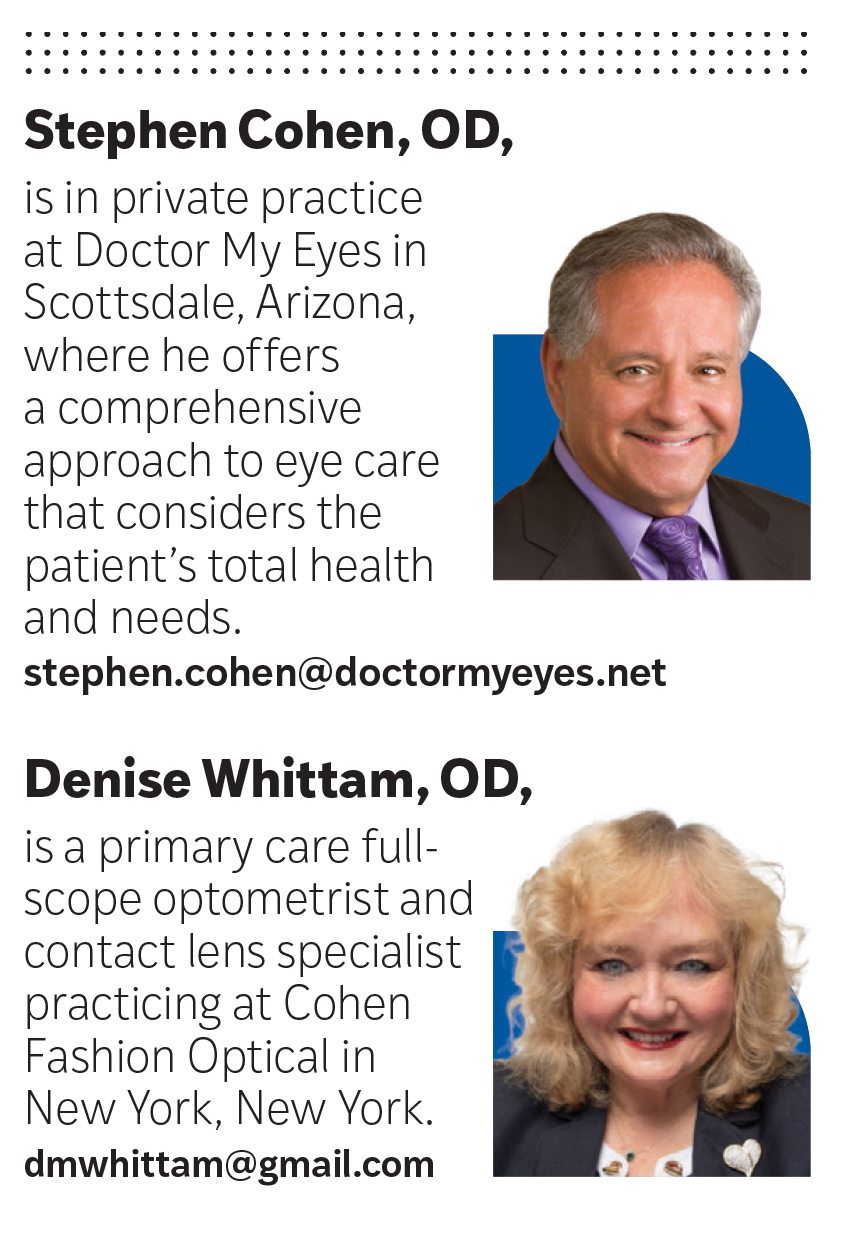Tackling the problem of contact lens dropout from presbyopia
With advanced, easy-to-fit multifocal lens technologies, patients don’t need to compromise


Contact lens specialists Stephen Cohen, OD, and Denise Whittam, OD, answer a few of the most pressing questions regarding the tendency of patients with presbyopia to discontinue contact lens use and offer their recommendations for how eye care professionals can treat this patient base.
How big is the problem of contact lens dropout due to presbyopia?
COHEN: Roughly half of contact lens wearers drop out by age 50. Most have worn contacts for years, but there is tremendous attrition when presbyopia sets in and patients notice changes in their reading. Age-related ocular surface problems contribute to dropout as well. Many patients at this age complain that their eyes feel gritty so they can’t wear their lenses all day. With the current dropout rate, the contact lens market is fl at: There are just as many patients dropping out as there are becoming new wearers.
WHITTAM: It’s frustrating for doctors to hear patients — who have worn contact lenses all their adult lives — say they’ve stopped. We have so many ways to help patients with presbyopia stay in contact lenses. We know that when patients are no longer getting the vision they expect, it’s time to educate them about the latest options in multifocals.
Related: Combatting dry eye during contact lens wear

If patients have already cut back on the time they spend in contact lenses or stopped wearing them, how do you persuade them back?
WHITTAM: It’s up to doctors to ask the right questions and have discussions about presbyopia. I tell patients that vision changes are a normal part of life but they don’t represent an end to wearing contact lenses. They don’t have to wear reading glasses over their single vision lenses or switch to progressives; new contact lenses can offer all the correction they need. I remind them of the many advantages of staying in contact lenses, from the freedom and youthful appearance to the full range of vision and great peripheral vision for sports.
And it’s very popular now to avoid fogged-up glasses from mask wearing. Many patients who are starting to drop out don’t know about multifocal lenses. Others have trialed them in the past or heard negative stories from friends. Maybe a doctor tried a trial lens on just 1 eye, which robs patients of depth perception and a lot of distance vision. Or perhaps they tried monovision and felt sick or couldn’t adapt to it. We need to educate patients and reassure them that new contact lens technologies have resolved the problems of the past.
COHEN: A lot of patients think they can’t wear multifocal contact lenses simply because no doctor ever suggested them. The first step is to let them know that we have multifocal contact lenses and they are good candidates. I want patients to trial multifocals and see the difference in their vision.
Related: 6 daily habits destroying your eyes
What choices are out there for presbyopic contact lens wearers?
COHEN: I think it’s important to follow new advances and be willing to try new lenses. We have excellent options for presbyopia, such as Air Optix plus HydraGlyde and Aqua (Alcon); Bausch + Lomb Ultra and BioTrue ONEday; and several Johnson & Johnson Vision Acuvue lenses, including the Moist Multifocal and the Acuvue Oasys Multifocal with Pupil Optimized Design. I have been most impressed by this lens and look forward to its availability in the 1-day Oasys platform as well. I start with a go-to lens that meets the greatest number of needs for the most patients. If a patient doesn’t fit under that big umbrella, then I select an alternative. To address vision changes and dry eye, the lens should be designed to maintain tear fi lm homeostasis and be minimally disruptive to the ocular surface.
WHITTAM: I offer 2 different multifocal lenses—a daily and a 2-week lens—but these days I’m leaning toward the Acuvue Oasys Multifocal with Pupil Optimized Design. My patients spend less than 10 minutes adapting to these lenses, and then I get a big smile because they see and feel the same as they did in their first contact lenses. The visual performance is great because they’ve optimized the lens for refractive error and pupil size. The lens matches the pupil and gives patients excellent depth of focus at all distances.
Related: New research addresses contact lens myths, misconceptions
Some doctors don’t like the fitting process for multifocal lenses. How do you make sure it’s successful and efficient?
WHITTAM: I think doctors were reluctant to put their patients in multifocal lenses because older technologies had shortcomings. Even when we followed the fitting instructions, the lens designs required patients to give up some distance or near vision, produced halos, and generally didn’t deliver the clarity that patients expected. Now we don’t need to compromise because new lenses have perfected it.
My chair time for fitting a multifocal lens is the same time as for a spherical lens, even with the pupil-optimized lens. I obtain a good refraction with ambient lighting and do a sensory dominant eye evaluation, and then I enter the numbers into the fitting calculator app on my phone, and it tells me the right lens. It’s not more difficult to fit than other contact lens.
COHEN: I start with a current refraction because even a little change can affect contact lens success. With multifocals, I simply stick to the fitting guide, which is the product of solid research. A lot of trial and error went into giving us what we need to get the right fit quickly and handle troubleshooting.
Related: The safety and efficacy of mass-produced colored contact lenses
To keep presbyopic patients in contact lenses, you’re treating OSD and putting them in high-tech, new multifocal lenses. Is it worth all the effort?
WHITTAM: Although there are many contact lens wearers who are over 40 years, very few of them wear multifocal contact lenses. If we don’t address the problem of dropout related to presbyopia, we will lose a lot of those contact lens patients.
In addition to retaining contact lens wearers, we can grow our contact lens practice by fitting emmetropes who have never worn glasses or contact lenses. They’re not used vision issues and they hate wearing reading glasses. I encourage them to try trial lenses that will correct their vision in a unobtrusive way.
COHEN: I think of switching a potential dropout into someone who continues wearing contact lenses as a boost for the practice on many levels—not just the revenue from a box of lenses. The average contact lens wearer comes back every 15 months, compared with 30 months for eyeglass wearers.
Every patient who drops out of contact lenses also skips half their office visits. When we solve their problems, they tell friends about their great new contacts that feel good all day. We’re creating enthusiasm, loyalty, and referrals for our practice.
Related: Five ways to stand out with specialty contact lenses

Newsletter
Want more insights like this? Subscribe to Optometry Times and get clinical pearls and practice tips delivered straight to your inbox.